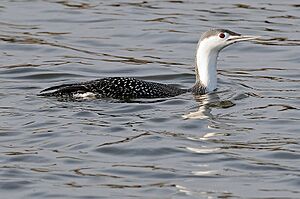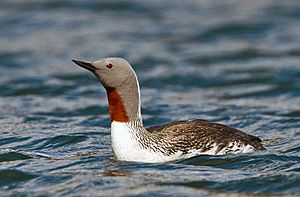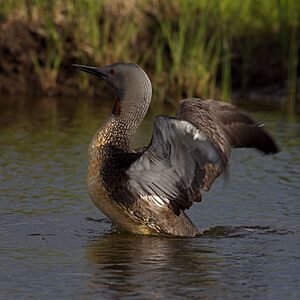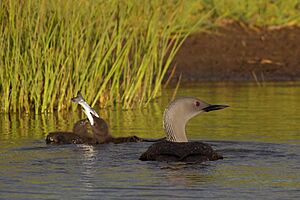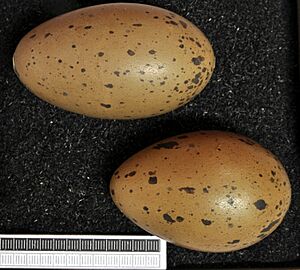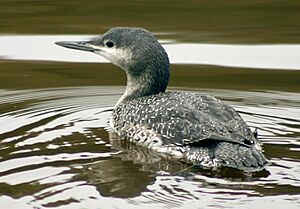Red-throated loon facts for kids
Quick facts for kids Red-throated loon |
|
|---|---|
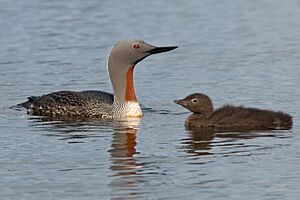 |
|
| Adult in breeding plumage and young | |
| Conservation status | |
| Scientific classification | |
| Genus: |
Gavia
|
| Species: |
stellata
|
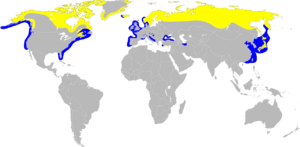 |
|
|
Breeding summer visitor
Winters at sea or Great Lakes
|
|
| Synonyms | |
|
|
The red-throated loon (also called the red-throated diver in Britain and Ireland) is a migratory aquatic bird. It lives in the northern parts of the world. This bird is the most common type of loon or diver. It mostly breeds in cold Arctic areas and spends its winters in coastal waters further south.
The red-throated loon is the smallest and lightest of all loons. It measures about 55 to 67 centimeters (22 to 26 inches) long. In winter, it looks plain grey on top and white underneath. But during the breeding season, it gets a bright reddish patch on its throat. This patch gives the bird its name. Red-throated loons mainly eat fish. They also sometimes eat amphibians, invertebrates, and plants. These birds are monogamous, meaning they stay with one partner for a long time. Both parents help build the nest, sit on the eggs (usually two), and feed their young.
Even though some groups of red-throated loons are shrinking, the bird has a large population worldwide. It also lives in a very wide area. Threats to this bird include oil spills, pollution, and getting caught in fishing nets. Animals like gulls, red foxes, and Arctic foxes sometimes eat their eggs and young. International agreements help protect the red-throated loon.
Contents
What's in a Name?
The red-throated loon was first described by a Danish scientist named Erik Pontoppidan in 1763. It is a monotypic species, which means it has no different subspecies, even though it lives in many places. Pontoppidan first put this bird in a group called Colymbus. This group included both loons and grebes.
Later, in 1788, a German scientist named Johann Reinhold Forster realized that loons and grebes were different. He moved the red-throated loon to its current group, Gavia. The name Gavia comes from a Latin word for "sea mew," used by an ancient Roman writer. The second part of its scientific name, stellata, is Latin for "starry." This refers to the bird's speckled back when it's not breeding.
Birds in the Gavidae family are called "loons" in North America and "divers" in Britain and Ireland. "Diver" describes how they hunt underwater. "Red-throated" simply points to their red throat patch. The word "loon" might come from old words meaning "lame" or "clumsy." This probably refers to how hard it is for loons to walk on land.
How to Spot a Red-Throated Loon
Like other loons, the red-throated loon is built for life in the water. Its bones are dense, helping it dive easily. Its legs are set far back on its body, which is great for pushing through water. Its body is long and smooth, and its pointed beak helps it glide underwater. Its feet are large and fully webbed, like paddles.
This loon is the smallest and lightest of all loon species. It is about 53 to 69 cm (21 to 27 in) long. Its wingspan is 91 to 120 cm (36 to 47 in), and it weighs 1 to 2.7 kg (2.2 to 6 lb). Both male and female loons look similar, but males are usually a bit bigger.
Plumage and Features
When breeding, the adult loon has a dark grey head and neck. It has thin black and white stripes on the back of its neck. Its throat has a triangular red patch, and its belly is white. Its back is dark grey-brown. It is the only loon with a completely dark back during breeding season.
When not breeding, its feathers are duller. Its chin, front of the neck, and most of its face are white. The top of its head and back of its neck are grey. Its dark back has many white speckles. Its eyes are red, and its legs are black on the outside and pale on the inside. Its webbed feet are pinkish-brown with darker edges.
Its beak is thin, straight, and sharp. It often points slightly upwards. One old name for this bird in North America was "pegging-awl loon." This refers to its sharp beak, which looks like a tool used by sailmakers. The beak changes color from black in summer to pale grey in winter.
When a red-throated loon chick hatches, it is covered in soft, fine down feathers. It is mostly dark brown or dark grey on top. Its head, neck, chest, and sides are slightly paler. Its lower chest and belly are pale grey. After a few weeks, these feathers are replaced by new ones. Young loons look similar to adults but have a darker forehead and neck. They also have heavy speckles on the sides of their neck and throat. Their back is browner and less speckled, and their belly has a brown tint. Their eyes are reddish-brown, and their beak is pale grey.
Flying High
When flying, the red-throated loon has a unique shape. Its small feet do not stick out much past its body. Its head and neck hang lower than its body, making it look a bit hunchbacked. Its thin wings are angled back. It flaps its wings faster and deeper than other loons.
What Does a Loon Say?
Adult red-throated loons make different sounds for different reasons.
- When flying past other loons or circling its pond, it makes quick, goose-like cackles, like kaa-kaa-kaa.
- If a human or predator disturbs it, it gives a short, croaking bark as a warning.
- It makes a low moaning sound with its beak closed. This is mostly used to talk to its mate or young, and sometimes during mating.
- It also has a short, wailing call, aarOOao...aarOOao..., which sounds a bit like a cat meowing.
- Another call is a harsh, cooing sound that goes up and down in pitch. This call is used when defending its territory or when pairs are bonding. Parents also use it to encourage their young to move between water bodies. This "long call" is often done as a duet, which is unusual for loons. The female's part is longer and softer than the male's.
Young loons make a high-pitched sound with their beak closed when they are begging for food or trying to contact their parents. They also have a "long call" similar to the adults.
Loon Look-Alikes
Up close, it's usually easy to tell a red-throated loon apart from other birds. But in certain light or from far away, it can be confused with the black-throated loon or even the great crested grebe. The red-throated loon has more white on its head and neck than the black-throated loon. It also usually shows more white on its sides, unless it's sitting very low in the water.
Where Red-Throated Loons Live

Red-throated loons mostly breed in the cold Arctic areas of northern Europe, Asia, and North America. This is generally north of 50°N latitude. They spend their winters in northern coastal waters. Sometimes, many of them gather together. For example, over 4,400 spend winter in the eastern part of the German Bight.
Unlike other loons, this species often uses very small freshwater lakes for breeding. Its smaller size helps it be more flexible. However, it cannot dive as deep for food as larger loons.
In North America, red-throated loons regularly winter along both coasts. They go as far south as the Baja California Peninsula and the Gulf of California in Mexico. In Europe, they breed in Iceland, northern Scotland, Scandinavia, and northern Russia. They winter along the coast as far south as parts of Spain. They are also seen on large inland waterways like the Mediterranean, Aegean, and Black Sea. In Asia, they breed in northern Siberia and winter along the Pacific coast, reaching China, Japan, and Taiwan.
Loon Behavior
Because their feet are so far back on their bodies, red-throated loons are clumsy on land. But they can push themselves forward on their chests. Young loons use this method to move from their small breeding ponds to larger rivers or the sea. This is the only loon species that can take off directly from land. If scared, it might dive underwater until only its head or beak is showing.
Red-throated loons are active during the day and migrate alone or in loose groups. They often fly high above the water. In eastern North America, they tend to fly near the coast. Siberian loons fly hundreds of miles over land to reach their wintering spots in southern Europe. They are strong flyers, reaching speeds of 75 to 78 km/h (47 to 48 mph). Like all loons, they lose all their flight feathers at once during a "wing moult". This makes them unable to fly for three to four weeks. Unlike other loons, which moult in late winter, red-throated loons lose their ability to fly between late summer and late autumn.
Food and Feeding
The red-throated loon mainly eats fish. It also sometimes eats molluscs, crustaceans, frogs, water invertebrates, insects, fish eggs, or even plants. It catches its prey underwater by grabbing it, not spearing it. It usually dives and swims using only its feet. But it can use its wings to turn or speed up quickly. Dives are usually 2 to 9 meters (7 to 30 feet) deep, and the bird stays underwater for about a minute.
Eating fish makes red-throated loons vulnerable to pollution like persistent organic pollutants and heavy metals. These harmful substances build up in their bodies. This can cause problems for long-lived animals like loons, which are at the top of the food chain.
For the first few days after hatching, both parents feed their young water insects and small crustaceans. After 3 to 4 days, the parents switch to feeding them small fish. By four weeks old, the young can eat the same size food as their parents. Young birds may still be fed by adults even after they can fly.
Reproduction and Life Cycle
Red-throated loons are monogamous, forming long-lasting pairs. Both male and female birds help build the nest. The nest is a shallow dip in the ground or sometimes a platform of mud and plants. It is lined with plants and a few feathers. Nests are usually built within 0.5 meters (20 inches) of a small pond's edge.
The female lays two eggs, though sometimes one or three eggs are laid. The eggs are incubated (kept warm) for 24 to 29 days, mostly by the female. The eggs are greenish or olive-brown with black spots. They measure about 75 x 46 mm (3 x 1.8 in) and weigh about 83 grams (2.9 oz). Incubation starts as soon as the first egg is laid, so the eggs hatch at different times. If the eggs are lost (for example, to predators or floods), the loon pair usually lays a second set of eggs, often in a new nest.
The young birds are precocial, meaning they are covered in down feathers and can move around with open eyes soon after hatching. Both parents feed them small water invertebrates at first, then small fish for 38 to 48 days. Parents will pretend to be hurt to draw predators away from the nest and their young.
The oldest known red-throated loon in the wild lived for over 23 years. It was found in Sweden after being ringed (banded) many years earlier.
Protecting the Red-Throated Loon
The red-throated loon is not a globally endangered species. It has a large population and lives in a wide area. However, some groups of loons are decreasing. For example, surveys in Alaska showed a 53% drop in population between 1971 and 1993. Numbers have also fallen in parts of Europe. But in Scotland, the population actually grew by about 16% between 1994 and 2006. In 2002, a group called Wetlands International estimated there were 490,000 to 1,500,000 red-throated loons worldwide.
The red-throated loon is protected by international agreements like the Agreement on the Conservation of African-Eurasian Migratory Waterbirds (AEWA). In the Americas, it is protected by the Migratory Bird Treaty Act of 1918.
Major threats to this bird include oil spills, damage to their homes, and getting tangled in fishing nets. Because they fly close to shore during migration, they can be affected by wind farms built near the coast. Studies show they tend to avoid wind farm areas. High levels of mercury in the environment have caused problems with breeding in some areas, like Sweden. Lakes becoming too acidic can also harm them, as the fish they eat are sensitive to low pH levels.
On their breeding grounds, Arctic and red foxes are big predators of loon eggs. Large gulls like great black-backed gulls and glaucous gulls also eat both eggs and young.
Red-throated loons can get sick from diseases like avian influenza and a type of botulism. They can also be harmed by toxins from "red tide" algal blooms. In 2007, many birds died from hypothermia during an algal bloom. This happened because a protein from the algae matted their feathers, making them lose their warmth.
Red-Throated Loons and People
People have used red-throated loons as a food source since ancient times. Even today, some indigenous peoples still hunt them in certain parts of the world. Both eggs and birds are taken. In one study in northern Canada, 73% of all red-throated loon eggs in a study area were collected by local people over two breeding seasons. In some parts of Russia, loon skins were traditionally used to make hats and decorations for clothing.
The red-throated loon was also important in the creation myths of many indigenous groups across the Holarctic. In these myths, which are similar even in far-apart places, a great shaman asked the loon to bring earth from the bottom of the sea. This earth was then used to create the dry land of the world.
As recently as the 1800s, people used the red-throated loon's behavior to predict the weather. People believed that if the birds flew inland or made short cries, it meant good weather. If they flew out to sea or made long, wailing cries, it meant rain was coming. In the Orkney and Shetland islands of Scotland, the bird is still called the "rain goose" because of this belief. People in the Faroe Islands thought that if the loon meowed like a cat, rain was near. But if it called gaa-gaa-gaa or turkatrae-turkatrae, it meant good weather.
Several countries and regions have put the red-throated loon on their postage stamps. These include Bhutan, Japan, Åland (a part of Finland), and the Union of the Comoros.
Images for kids



